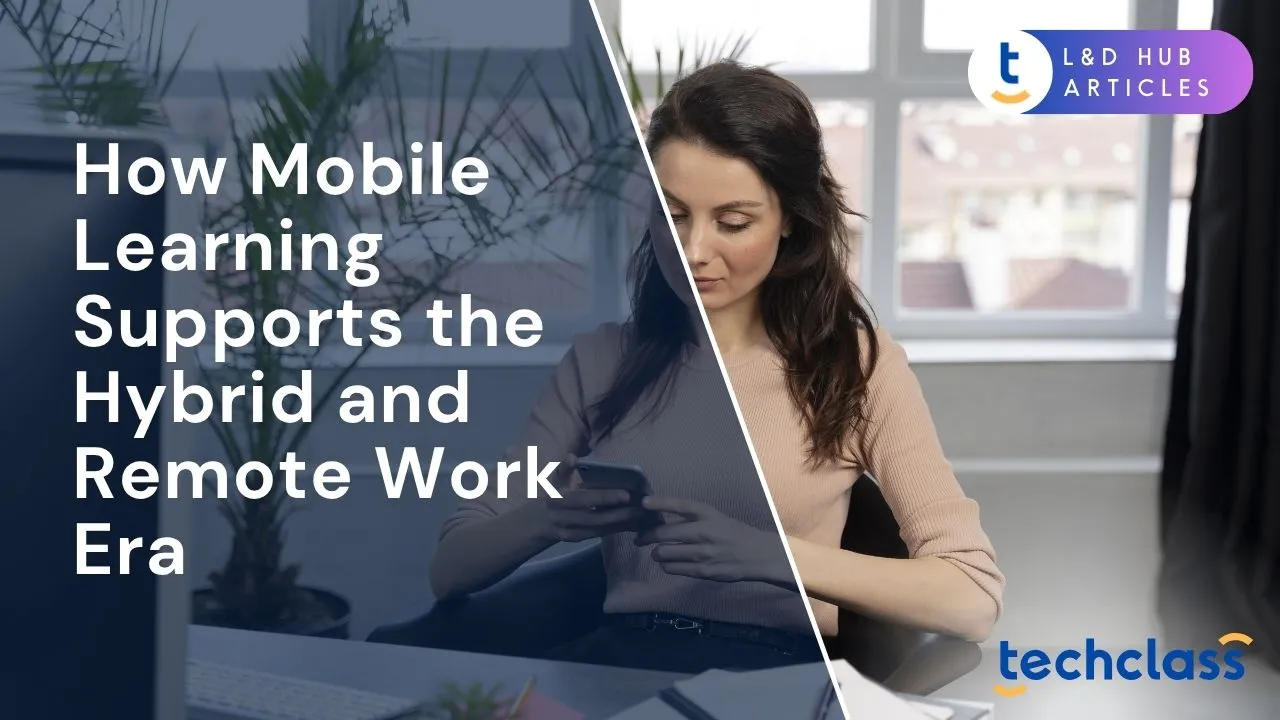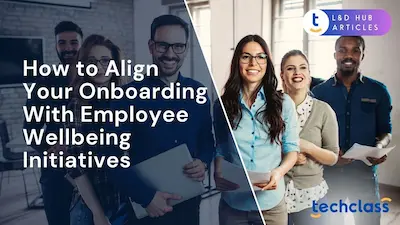A New Era of Work, A New Era of Learning
The landscape of work has transformed dramatically in recent years. Hybrid and remote work arrangements – once a novelty – are now commonplace, with roughly half of organizations embracing hybrid models in the post-pandemic era [1]. This shift has unlocked flexibility and autonomy for employees, but it also presents new challenges for how businesses train and develop their people. Dispersed teams can face communication gaps, inconsistent knowledge transfer, and onboarding difficulties that traditional in-person training struggles to overcome [2]. To adapt, companies need learning solutions as flexible and agile as today’s work environment. This is where mobile learning comes in. Mobile learning (often called mLearning) refers to training and educational content delivered via smartphones, tablets, or other portable devices, enabling employees to access learning resources anytime and anywhere. In the hybrid and remote work era, mobile learning has emerged as a critical strategy, one that empowers employees to learn on the go and helps organizations keep their workforce skilled, engaged, and aligned [3].
In this article, we’ll explore how mobile learning supports the hybrid and remote work era. We’ll define what mobile learning entails, examine its key benefits for distributed teams, discuss real-world examples and evidence of its impact, and offer tips for implementing mobile learning in your organization.
The Hybrid Work Era: New Learning Challenges
Hybrid working brings together on-site and remote employees, offering flexibility but also introducing multiple challenges for HR and L&D (Learning & Development) professionals. In a dispersed workforce, maintaining consistency in training and communication is harder. Employees working from home might miss the informal knowledge-sharing that happens in an office. New hires onboarding remotely may feel less supported, and teams spread across time zones can struggle to attend the same live training sessions. According to industry analyses, hybrid work models tend to create issues like communication gaps and uneven knowledge transfer if companies stick to old training methods [2]. Traditional classroom training or day-long workshops simply don’t fit this new reality – not only are they hard to schedule for distributed teams, but they also fail to engage employees who are accustomed to digital, on-demand experiences.
To address these challenges, organizations have increasingly turned to eLearning and digital training solutions [2]. Early in the remote work boom, many companies digitized their training programs out of necessity. Now, the focus is on refining these programs to be more scalable, engaging, and tailored to a hybrid workforce. HR professionals and business leaders are recognizing that simply putting slide decks or recorded webinars online is not enough. The mode of delivery matters greatly. Training needs to meet employees where they are – which, often, is not sitting in a corporate office or even at a laptop during standard hours. This is why mobile learning has gained traction as a cornerstone of modern workforce development. By leveraging the devices that nearly every employee has in their pocket, organizations can overcome many hybrid training challenges: delivering consistent content to everyone, keeping remote employees engaged, and making learning opportunities accessible regardless of location or schedule.
What Is Mobile Learning and Why It Matters Now
Mobile learning is more than a buzzword; it’s a modern approach to training that aligns perfectly with the hybrid work era. In essence, mobile learning means any learning activity or material that employees can access on a mobile device (like a smartphone or tablet). Instead of being tied to a classroom or a desktop computer, learners have the freedom to engage with training anytime, anywhere – whether it’s during a commute, between meetings, or from a home office. This on-the-go accessibility is a game-changer for today’s workforce.
Crucially, mobile learning isn’t just traditional eLearning shrunk down to a small screen. It leverages the unique features of mobile devices and modern content design to create an experience that’s effective and user-friendly. That often means short, micro-learning modules that can be completed in a few minutes, multimedia elements like videos or interactive quizzes optimized for touchscreens, and platforms that save your progress so you can learn in bite-sized chunks. The content is typically designed to be responsive (adapting to different screen sizes) and can often be consumed offline or asynchronously. For example, an employee might watch a 5-minute how-to video on their phone while waiting for a meeting to start, or complete a quick quiz on an app as a refresher after a training session. These small learning moments add up to meaningful skill development without pulling employees away from their work for long stretches.
Mobile learning has surged in importance now because it directly addresses the needs of a hybrid workforce. With teams distributed across various locations, work hours becoming more flexible, and many employees balancing professional and personal responsibilities in the same space, learning also needs to become more flexible. Mobile learning meets employees where they are: on their personal devices and on their own schedules. Studies show that employees are increasingly expecting this flexibility – by 2024, roughly 75% of U.S. employees had used mobile devices for work-related learning, reflecting how integrated mobiles have become in daily routines [4]. In response, companies are making mobile learning a priority. It’s viewed not just as a convenient add-on, but as a must-have strategy for keeping skills sharp in the modern workplace. In fact, the rise of hybrid and remote work has shone a spotlight on the limitations of old training formats, and mobile learning offers solutions aligned with today’s realities [4]. Companies that embrace mobile learning often find that employees complete more training when it’s available on their phones, leading to higher engagement and knowledge retention. All of these factors explain why mobile learning matters now: it provides a path to continuous learning and development that is compatible with the new world of work.
Key Benefits of Mobile Learning for Hybrid & Remote Teams
Adopting mobile learning can yield significant benefits for both employees and organizations. Below, we outline the key advantages of mobile learning in a hybrid or remote work setting:
- Flexibility and “Anywhere, Anytime” Access: Perhaps the most obvious benefit, mobile learning lets employees access training materials whenever and wherever they need to. This is vital when teams span different time zones or follow varied schedules. A sales representative on the road can brush up on product knowledge from a tablet in a hotel room; a remote employee can complete a compliance module from their phone at home. Learning no longer has to be a fixed event on the calendar, it becomes an integral part of the flow of work. This flexibility ensures that professional development fits around daily routines rather than disrupting them. It also means training can happen in real time at the point of need. For instance, if a remote worker encounters a problem with a new software tool, they can instantly access a quick tutorial or FAQ on their mobile device for just-in-time support [4]. By breaking the dependency on physical classrooms or live trainers, mobile learning democratizes access to knowledge across the organization.
- Consistency and Scalability of Training: With a dispersed workforce, ensuring everyone receives the same quality of training is a known hurdle. Mobile learning helps standardize the learning experience. Digital courses or learning apps deliver uniform content to all employees, whether they’re in HQ or working from a small town. This uniformity helps close knowledge gaps between remote and in-office staff. Everyone gets up-to-date information and follows the same best practices. Moreover, mobile learning content is highly scalable – once developed, a module can be rolled out to tens or thousands of employees with equal ease. This makes it practical for HR and L&D teams to train large, geographically spread teams on new policies, products, or skills simultaneously. It’s also cost-effective: companies save on travel, venues, and instructor fees that traditional training would require. In short, mobile learning provides a consistent platform for upskilling the workforce at scale [2], a critical need when organizations must adapt quickly to change.
- Higher Engagement through Interactive Learning: Mobile learning has proven adept at capturing learners’ attention and keeping them engaged. One reason is the format – content is often delivered in shorter, focused segments (microlearning) that are easier to digest than long lectures or manuals. Additionally, mobile learning platforms commonly include interactive and multimedia elements that make learning more fun and rewarding. Gamification is a popular technique: incorporating quizzes, challenges, badges, or leaderboards turns training into a game-like experience. For example, employees might earn points for completing modules or compete with colleagues on knowledge quizzes. These elements tap into people’s natural motivations and can significantly boost participation. Social learning features (such as discussion forums or team challenges within a learning app) allow remote employees to share ideas and learn from peers, recreating some of the camaraderie of in-person training in a virtual way [4]. The result of these strategies is better engagement and knowledge retention. Employees are not just passively reading or watching; they are actively interacting with the content. Studies indicate that using mobile-friendly microlearning and gamified exercises can improve knowledge retention and course completion rates, translating into more effective learning outcomes [3]. Over time, better engagement in training also correlates with improved on-the-job performance, since employees are more likely to actually apply what they learn.
- On-Demand Learning and Performance Support: In a fast-paced hybrid work environment, employees often need information and learning “in the moment.” Mobile learning enables this through on-demand access to resources. If a remote worker encounters a new challenge – say, figuring out how to use a feature in a software tool or handling an unexpected client question – mobile learning resources can be at their fingertips to provide quick answers. This just-in-time learning aspect is incredibly valuable for reinforcing skills and bridging small knowledge gaps as they arise. It empowers employees to solve problems independently, increasing their confidence and competence. Moreover, mobile learning supports continuous learning habits. Instead of a one-off training event, learning becomes an ongoing process woven into everyday work life. For example, hybrid employees might make it a routine to complete a short learning activity on their phone each day after lunch, or watch a tutorial video during a break. This regular reinforcement helps combat the “forgetting curve” – the tendency to forget information if it’s not applied, by periodically refreshing and extending knowledge [3]. In essence, mobile learning acts as a constant learning companion for employees, which is especially useful when they don’t have co-workers or managers physically nearby to ask for help.
- Personalization and Adaptability: Modern mobile learning platforms often harness technology (like AI-driven analytics) to personalize the learning experience for each individual. For distributed teams composed of diverse roles and skill levels, a one-size-fits-all training program can leave many employees unengaged or unchallenged. Mobile learning can address this by tailoring content recommendations or learning paths based on the learner’s needs and progress. For instance, an app might suggest additional practice in areas where an employee scored poorly on a quiz, or it might allow learners to choose topics relevant to their career goals. This level of personalization ensures that each employee’s development is targeted and relevant, which can improve motivation. From the organization’s perspective, it means training is more effective, employees spend time on the skills that matter most for their role or growth. Additionally, because mobile content can be updated or changed quickly, it’s adaptable. HR teams can rapidly push out new modules (say, for a policy update or emerging skill requirement) and be confident that every team member will see the latest content on their device. This adaptability is crucial in the hybrid era, where business needs and external conditions can change suddenly.
- Improved Training Outcomes and ROI: Ultimately, the goal of any training initiative is to drive better performance and results. Mobile learning supports this in measurable ways. By making learning more accessible and engaging, it often leads to higher completion rates for training programs – employees actually finish the courses they start. They also tend to learn more effectively thanks to the interactive and on-demand nature of mobile content. Many organizations report tangible improvements after shifting to mobile learning. For example, companies that implement mobile learning have observed increases in employee engagement with training, better knowledge retention, and even direct performance boosts such as higher sales or improved customer service scores. There’s also a financial argument: mobile learning can deliver a strong return on investment (ROI) through both cost savings and productivity gains. One mid-sized tech company, for instance, saw a 30% improvement in ROI after introducing a mobile-first learning approach for its hybrid workforce [4]. This was attributed to factors like reduced training costs, faster upskilling, and improved employee satisfaction. Indeed, employees often appreciate the freedom and support that mobile learning provides, which can enhance morale and retention. In a time when talent retention is paramount, offering professional development in a user-friendly, flexible format can be a differentiator for employee experience.
By capitalizing on these benefits, mobile learning helps HR leaders and business owners ensure that having a hybrid or remote workforce is a strength rather than a setback. It turns the challenge of distance into an opportunity, an opportunity to reimagine learning as a continuous, personalized journey that fits seamlessly into the way we work now.
Implementing Mobile Learning in Your Organization
Adopting mobile learning is not simply about buying a new piece of software; it requires a thoughtful strategy to be successful. Below are some best practices and steps for HR professionals and business leaders to consider when implementing mobile learning in their organizations:
- Assess Your Workforce’s Needs: Start by identifying the skills gaps and training needs across your workforce. What knowledge or competencies do your employees need most in the hybrid/remote context? Perhaps your teams need better training on digital collaboration tools, or managers require guidance on leading virtual teams. Conduct surveys or consult with department heads to prioritize the content areas for your mobile learning initiatives. Understanding your learners (their roles, locations, tech proficiency, etc.) will also inform the type of mobile content that will work best. For example, a field service team might benefit from short video tutorials and offline access (since they may have limited connectivity), whereas a remote software team might need interactive simulations for complex technical training.
- Choose the Right Platform (Mobile-Friendly LMS): Selecting the appropriate technology platform is crucial. You’ll likely need a Learning Management System (LMS) or learning platform that is mobile-friendly by design. Many modern LMS platforms support mobile access, but not all are equal in user experience. Look for a solution that offers a robust mobile app or a responsive web interface, allowing learners to easily navigate courses on a small screen. The platform should support the content formats you plan to use (videos, quizzes, e-books, etc.) and ideally allow for offline viewing of content when internet access is an issue. Integration capabilities are important too – the LMS should ideally integrate with your existing HR systems or collaboration tools so that training data can be tracked and tied into other employee metrics. Ease of use is paramount: employees won’t embrace the system if it’s clunky on their phone. Many organizations pilot a platform with a small group of users first to gather feedback on the mobile experience before wider rollout.
- Design Engaging, Mobile-Optimized Content: When developing training content for mobile learning, short and visually engaging should be your mantra. Break down learning material into bite-sized modules (microlearning), each focusing on a specific topic or skill. Use multimedia elements – for example, a 3-minute instructional video, an infographic, or a quick interactive quiz – to cater to different learning styles and keep things interesting. Avoid long text passages that require excessive scrolling on a phone. Instead, use bullet points, crisp summaries, and graphics to convey information efficiently. Interactive content tends to perform well on mobile: scenarios or branched quizzes where learners can make choices, flashcard drills for key terms, or gamified exercises can greatly enhance engagement. Also, consider incorporating push notifications or reminders through the learning app to nudge learners to continue courses or take new ones. These can help maintain momentum in a self-paced environment. Remember to design with the user in mind – test your content on actual mobile devices to ensure readability and functionality. If your workforce is global or diverse, you might also offer content in multiple languages or include subtitles on videos, as mobile learning can easily support multilingual content [4].
- Foster a Learning Culture and Encourage Participation: Simply offering mobile learning won’t yield results unless employees are motivated to use it. HR and leadership play a key role in building a culture that encourages continuous learning. Communicate to your staff why mobile learning is being introduced – emphasize the personal benefits (e.g. skill growth, career development, convenience) as well as the business goals. Encourage managers to lead by example: when team leaders actively take courses and talk about what they’re learning, it signals to their teams that development is valued. You can also create some healthy competition or community around learning. For instance, highlight top course completers in internal newsletters, or set up a friendly challenge (with small rewards or recognition) for teams to finish certain crucial training modules. Many organizations launch mobile learning with an initial campaign or “launch event” to get employees excited, perhaps a webinar demoing the new app, or a limited-time incentive for those who sign up and complete a module early. Ongoing, make sure to solicit feedback from employees about the mobile learning experience. User feedback can alert you to technical issues, content gaps, or ideas for improvement. Showing that you listen and refine the program will further engage learners.
- Leverage Data and Iterate: One of the advantages of digital learning platforms is the wealth of data they provide. Use your LMS analytics to track participation rates, course completion, quiz scores, and other relevant metrics. These insights can help you identify what’s working and what isn’t. For example, if you notice a particular module has a high drop-off rate on mobile, it might indicate the content is too long or not engaging enough for that format – a cue to redesign it. If certain topics are very popular, you might prioritize creating more content in those areas. Also pay attention to performance metrics outside the learning system. Are you seeing improvements in the workplace that correlate with training completion (e.g. a decrease in IT support tickets after rolling out a mobile cybersecurity training)? Such correlations can help build the business case for further investment in mobile learning. Regularly review your strategy – perhaps quarterly – and be ready to iterate. Technology and employee needs will evolve, especially as the hybrid work era continues to mature. Keep an eye on new features (like emerging AI-based personalized learning tools or VR/AR options on mobile) that could enhance your program down the line. Remember, implementing mobile learning is not a one-time project but an ongoing process of improvement.
By following these steps, organizations can integrate mobile learning smoothly into their training ecosystem. When done right, mobile learning becomes a powerful tool in the HR toolkit, not only delivering knowledge, but also boosting engagement and fostering a mindset of continuous growth among employees. It aligns training with the flexibility of hybrid work, ensuring that development opportunities are no longer constrained by geography or schedule.
Final Thoughts: Embracing Mobile Learning for the Future of Work
As hybrid and remote work solidify their place in the business world, the way we approach employee learning and development must also evolve. Mobile learning has proven to be more than just an adaptation to pandemic-era constraints; it’s a forward-looking strategy that resonates with the values of today’s workforce – flexibility, autonomy, and continual growth. By enabling learning to happen anywhere and at any time, mobile learning turns every moment into a potential learning opportunity, and every employee’s device into a personal development hub.
For HR professionals and enterprise leaders, championing mobile learning is an investment in building a more resilient and agile organization. It means your teams can rapidly upskill as new challenges arise, whether that’s adopting the latest software, complying with new regulations, or honing soft skills for better collaboration. It means a new hire in a remote location can get the same rich onboarding experience as someone at headquarters. It means learning becomes a natural, integrated part of the workday rather than a disruptive event. Companies that have embraced mobile learning are already reaping benefits in engagement and performance – from higher training completion rates to improvements in employee satisfaction and retention [4]. These outcomes contribute directly to a stronger company culture and better business results.
Importantly, mobile learning also future-proofs your training programs. Technology and work practices will continue to change, and mobile learning platforms are evolving right along with them. Trends suggest even more personalized, immersive, and mobile-first learning experiences are on the horizon – think AI-driven coaching chatbots or augmented reality training scenarios that employees can run from their phones [3][6]. By laying a foundation now, you prepare your organization to take advantage of these innovations when the time comes.
In conclusion, supporting your hybrid and remote workforce with mobile learning is a smart and necessary move in this era. It aligns learning with life in a flexible work world, empowering employees to take charge of their development and perform at their best. As you consider the next steps, remember that successful mobile learning implementation is as much about culture as it is about technology. Encourage curiosity, celebrate learning achievements, and continuously adapt to your people’s needs. In doing so, you’ll cultivate a learning ecosystem that not only supports your current hybrid work reality but also equips your organization to thrive in the future of work.
FAQ
What is mobile learning and how does it support hybrid and remote work?
Mobile learning involves accessing training content via smartphones or tablets, providing employees with flexible, anytime-anywhere access to learning resources to address the challenges of dispersed teams.
What are the main benefits of mobile learning for hybrid and remote teams?
Key benefits include flexibility in access, consistent and scalable training, higher engagement through interactive content, on-demand support, and personalized learning experiences.
How can organizations effectively implement mobile learning?
Organizations should assess workforce needs, choose mobile-friendly LMS platforms, design engaging short-form content, foster a learning culture, leverage data for continuous improvement, and encourage participation.
Why has mobile learning become crucial in the era of hybrid and remote work?
Because it addresses the need for flexible, accessible, and engaging training that suits dispersed teams across different locations and schedules, enhancing skills and knowledge retention.
How does mobile learning improve training outcomes and ROI?
It increases completion rates, boosts engagement, enhances knowledge retention, and reduces costs, resulting in better performance and measurable organizational benefits.
References
- Hybrid Work in Retreat? Barely. – Gallup. Available from: https://www.gallup.com/workplace/694361/hybrid-work-retreat-barely.aspx
- Remote Work Training: The Role Of eLearning In Hybrid Teams. – eLearning Industry. Available from: https://elearningindustry.com/remote-work-training-the-role-of-elearning-in-hybrid-teams
- 7 Examples of Mobile Learning that Elevate the Hybrid Workforce Learning Experience. – EI Design (Soma Bhaduri). Available from: https://www.eidesign.net/7-examples-of-mobile-learning-that-elevate-the-hybrid-workforce-learning-experience/
- Why Mobile Learning Is the Future of Workforce Training in the USA (2025 Trends and Insights). – Creativ Technologies (Blog). Available from: https://creativtechnologies.com/2025/05/15/mobile-learning-future-of-workforce-training-in-the-usa/
- 5 Ways Digital Learning Keeps Your Hybrid Workforce Engaged. – Open LMS (Bill Conran). Available from: https://www.openlms.net/au/blog/corporate/au/5-ways-digital-learning-keeps-hybrid-workforce-engaged/
- eLearning Content Development: The Most Important Trends To Watch In 2025. – eLearning Industry. Available from: https://elearningindustry.com/elearning-content-development-the-most-important-trends-to-watch-in-2025
Weekly Learning Highlights
Get the latest articles, expert tips, and exclusive updates in your inbox every week. No spam, just valuable learning and development resources.



